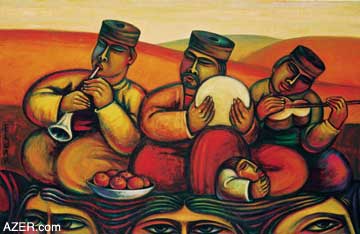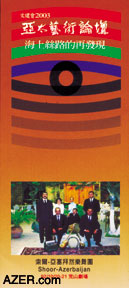|

Winter 2003 (11.4)
Page
25
Azerbaijani Mugham
Declared
Masterpiece of Oral World Heritage by UNESCO
by Sana Baghirova
  On
November 7, 2003, UNESCO held a special awards ceremony in Paris,
identifying 28 "Declared Masterpieces of Oral & Intangible
Heritage of the World". Azerbaijani Mugham was one of the
genres chosen for this program, now in its second year of existence.
Last year, 19 awards were presented; the third Proclamation is
scheduled for 2005. On
November 7, 2003, UNESCO held a special awards ceremony in Paris,
identifying 28 "Declared Masterpieces of Oral & Intangible
Heritage of the World". Azerbaijani Mugham was one of the
genres chosen for this program, now in its second year of existence.
Last year, 19 awards were presented; the third Proclamation is
scheduled for 2005.
Mugham is a musical term, which refers to improvised modal music
with a melody, free of meter. It is also a general term applied
to Azerbaijani traditional art music.
Mr. Koichiro Matsuura, Director General of UNESCO, stated that
the goal of the Masterpieces Program is to raise public awareness
of the value of this heritage and encourage governments to take
legal and administrative steps to preserve it.
Other Masterpiece groups were from Belgium, Bolivia, Brazil,
Central African Republic, Cambodia, China, Colombia, Cuba, Egypt,
Estonia, India, Indonesia, Jamaica, Japan, Kyrgzystan, Madagascar,
Mexico, Mongolia, Korea, Tonga, Turkey, Vanuatu, Vietnam, Iraq
and Yemen. A detailed description and photographs of the masterpieces
can be downloaded: co.org/culture/heritage/ intangible/masterpieces/list2003
These Masterpiece awards are not limited to music. For example,
this year the know-how of itinerant doctors in South America
who are familiar with the properties of nearly 1,000 plant species
was recognized, as was a communication system among different
language communities in Vanuatu who use finger drawings in sand,
and the woodcrafting knowledge of the Zafimaniry in Madagascar.
Below: A trio of traditional instruments -
zurna, gaval and tar. However, mugham trios traditionally include
the stringed instruments tar and kamancha while the gaval is
used by the singer (khananda) to establish the rhythm. Here artist
Eldar Babazade indicates the folkloric roots of Azeri modal music
is through women, perhaps via lullabies. See more of Babazade's
works at AZgallery.org. Mobile: (994-50) 353-1293.
  The
2003 Masterpiece jury was comprised of 18 experts who examined
56 candidatures. Ramiz Abutalibov, Azerbaijan's veteran representative
to UNESCO, was the driving force in helping to coordinate this
work with Paris. The
2003 Masterpiece jury was comprised of 18 experts who examined
56 candidatures. Ramiz Abutalibov, Azerbaijan's veteran representative
to UNESCO, was the driving force in helping to coordinate this
work with Paris.
The Candidature was quite complex and consisted of written text,
video documents (one 10-minute video, and another video 5-6 hours
long), photos, bibliography and a list of human resources.
French Ethnomusicolgist Jean During was selected as the international
expert for preparation of this file, while I was invited as the
national expert. Mr.
During prepared a 50-page text, while I wrote one of 40 pages.
The text also required identifying various projects, aimed at
safeguarding and preserving mugham, and promoting it in Azerbaijan
and throughout the world.
The bibliography included books such as Uzeyir Hajibeyov's "Principles
of Azerbaijani Folk Music", Afrasiyab Badalbayli's "Musigi
Lughati" (Musical Dictionary), Jean During's, "La Musique
Traditionelle de l'Azerbayjan et la Science des Mugams",
and Feridun Shushinsky's works.
  At the
Awards Ceremony, Azerbaijan's distinguished mugham performer
Alim Gasimov gave a live performance, impressive as always. [To
read more about Alim, SEARCH at AZER.com]. At the
Awards Ceremony, Azerbaijan's distinguished mugham performer
Alim Gasimov gave a live performance, impressive as always. [To
read more about Alim, SEARCH at AZER.com].
Following the Awards Ceremony, on November 14, 2003, the UN Radio
broadcast an interview with me related to Azerbaijan's mugham
and played samples performed by Habil Aliyev (kamancha), Haji
Mammadov (tar), Shovkat Alakbarova (vocal), and Vagif Mustafazade
(piano, jazz-mugham).
Mugham in Taipai
Another major international event related to Azerbaijani mugham
took place on October 17-26 in Taipei at the Asia Pacific Arts
Forum 2003. Organized in collaboration with the Taipei National
University of the Arts, the program included a symposium and
musical festival. More than 100 participants were invited to
the forum from the U.S., France, Belgium, Japan, Russia, Indonesia,
India, Sri Lanka and Malaysia.
Azerbaijan was represented by Shur Azerbaijan which includes
five musicians: Zabit Nabizade (singer or "khananda"),
Mohlat Muslumov (tar), Fahraddin Dadashev (kamancha), Aydin Aliyev
(garmon, an instrument somewhat like an accordion), and Elshan
Gasimov (naghara, like drums). Shur Azerbaijan gave three concerts
which were very well accepted.
Sana Baghirova is Senior Researcher
at the Institute for Architecture and Arts, which is part of
the Azerbaijan National Academy of Sciences. She represented
Azerbaijan in preparing the Candidature for the UNESCO Masterpiece
awards and organized and accompanied Shur Azerbaijan to Taipei
where she also presented a paper and gave a Master class.
Back to Index
AI 11.4 (Winter 2003)
AI Home
| Search | Magazine
Choice
| Topics
| AI Store | Contact us
Other Web sites
created by Azerbaijan International
AZgallery.org | AZERI.org | HAJIBEYOV.com
|



